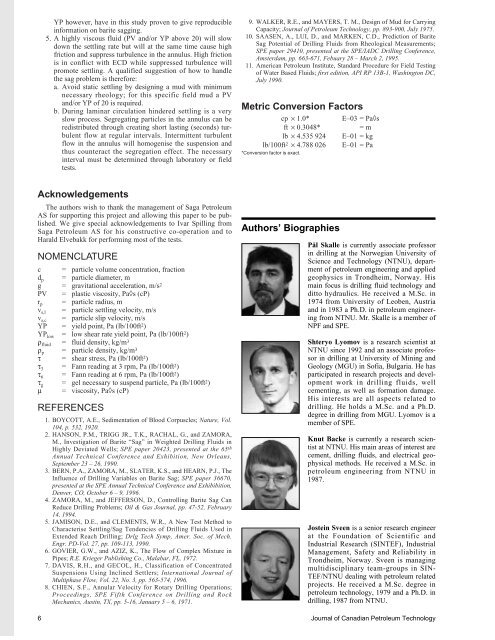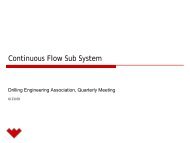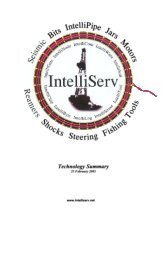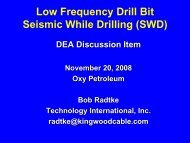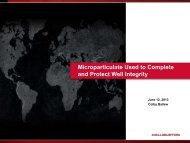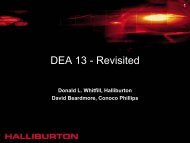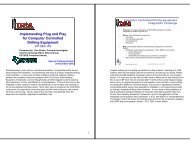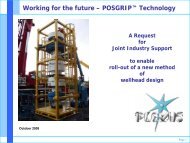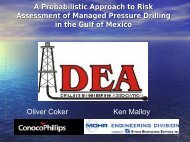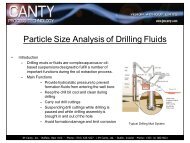JCPT-paper-on-Sag - Drilling Engineering Association
JCPT-paper-on-Sag - Drilling Engineering Association
JCPT-paper-on-Sag - Drilling Engineering Association
Create successful ePaper yourself
Turn your PDF publications into a flip-book with our unique Google optimized e-Paper software.
YP however, have in this study proven to give reproducibleinformati<strong>on</strong> <strong>on</strong> barite sagging.5. A highly viscous fluid (PV and/or YP above 20) will slowdown the settling rate but will at the same time cause highfricti<strong>on</strong> and suppress turbulence in the annulus. High fricti<strong>on</strong>is in c<strong>on</strong>flict with ECD while suppressed turbulence willpromote settling. A qualified suggesti<strong>on</strong> of how to handlethe sag problem is therefore:a. Avoid static settling by designing a mud with minimumnecessary rheology; for this specific field mud a PVand/or YP of 20 is required.b. During laminar circulati<strong>on</strong> hindered settling is a veryslow process. Segregating particles in the annulus can beredistributed through creating short lasting (sec<strong>on</strong>ds) turbulentflow at regular intervals. Intermittent turbulentflow in the annulus will homogenise the suspensi<strong>on</strong> andthus counteract the segregati<strong>on</strong> effect. The necessaryinterval must be determined through laboratory or fieldtests.9. WALKER, R.E., and MAYERS, T. M., Design of Mud for CarryingCapacity; Journal of Petroleum Technology, pp. 893-900, July 1975.10. SAASEN, A., LUI, D., and MARKEN, C.D., Predicti<strong>on</strong> of Barite<strong>Sag</strong> Potential of <strong>Drilling</strong> Fluids from Rheological Measurements;SPE <str<strong>on</strong>g>paper</str<strong>on</strong>g> 29410, presented at the SPE/IADC <strong>Drilling</strong> C<strong>on</strong>ference,Amsterdam, pp. 663-671, Febuary 28 – March 2, 1995.11. American Petroleum Institute, Standard Procedure for Field Testingof Water Based Fluids; first editi<strong>on</strong>, API RP 13B-1, Washingt<strong>on</strong> DC,July 1990.Metric C<strong>on</strong>versi<strong>on</strong> Factorscp × 1.0*ft × 0.3048*lb × 4.535 924lb/100ft 2 × 4.788 026*C<strong>on</strong>versi<strong>on</strong> factor is exact.E–03 = Pa◊s= mE–01 = kgE–01 = PaAcknowledgementsThe authors wish to thank the management of <strong>Sag</strong>a PetroleumAS for supporting this project and allowing this <str<strong>on</strong>g>paper</str<strong>on</strong>g> to be published.We give special acknowledgements to Ivar Spilling from<strong>Sag</strong>a Petroleum AS for his c<strong>on</strong>structive co-operati<strong>on</strong> and toHarald Elvebakk for performing most of the tests.NOMENCLATUREc = particle volume c<strong>on</strong>centrati<strong>on</strong>, fracti<strong>on</strong>d p = particle diameter, mg = gravitati<strong>on</strong>al accelerati<strong>on</strong>, m/s 2PV = plastic viscosity, Pa◊s (cP)r p = particle radius, mv s,l = particle settling velocity, m/sv s,c = particle slip velocity, m/sYP = yield point, Pa (lb/100ft 2 )YP low = low shear rate yield point, Pa (lb/100ft 2 )ρ fluid = fluid density, kg/m 3ρ p = particle density, kg/m 3τ = shear stress, Pa (lb/100ft 2 )τ 3 = Fann reading at 3 rpm, Pa (lb/100ft 2 )τ 6 = Fann reading at 6 rpm, Pa (lb/100ft 2 )τ g = gel necessary to suspend particle, Pa (lb/100ft 2 )µ = viscosity, Pa◊s (cP)REFERENCES1. BOYCOTT, A.E., Sedimentati<strong>on</strong> of Blood Corpuscles; Nature, Vol.104, p. 532, 1920.2. HANSON, P.M., TRIGG JR., T.K., RACHAL, G., and ZAMORA,M., Investigati<strong>on</strong> of Barite “<strong>Sag</strong>” in Weighted <strong>Drilling</strong> Fluids inHighly Deviated Wells; SPE <str<strong>on</strong>g>paper</str<strong>on</strong>g> 20423, presented at the 65 thAnnual Technical C<strong>on</strong>ference and Exhibiti<strong>on</strong>, New Orleans,September 23 – 26, 1990.3. BERN, P.A., ZAMORA, M., SLATER, K.S., and HEARN, P.J., TheInfluence of <strong>Drilling</strong> Variables <strong>on</strong> Barite <strong>Sag</strong>; SPE <str<strong>on</strong>g>paper</str<strong>on</strong>g> 36670,presented at the SPE Annual Technical C<strong>on</strong>ference and Exhibibiti<strong>on</strong>,Denver, CO, October 6 – 9, 1996.4. ZAMORA, M., and JEFFERSON, D., C<strong>on</strong>trolling Barite <strong>Sag</strong> CanReduce <strong>Drilling</strong> Problems; Oil & Gas Journal, pp. 47-52, February14, 1994.5. JAMISON, D.E., and CLEMENTS, W.R., A New Test Method toCharacterise Settling/<strong>Sag</strong> Tendencies of <strong>Drilling</strong> Fluids Used inExtended Reach <strong>Drilling</strong>; Drlg Tech Symp, Amer. Soc. of Mech.Engr. PD-Vol. 27, pp. 109-113, 1990.6. GOVIER, G.W., and AZIZ, K., The Flow of Complex Mixture inPipes; R.E. Krieger Publishing Co., Malabar, FL, 1972.7. DAVIS, R.H., and GECOL, H., Classificati<strong>on</strong> of C<strong>on</strong>centratedSuspensi<strong>on</strong>s Using Inclined Settlers; Internati<strong>on</strong>al Journal ofMultiphase Flow, Vol. 22, No. 3, pp. 563-574, 1996.8. CHIEN, S.F., Annular Velocity for Rotary <strong>Drilling</strong> Operati<strong>on</strong>s;Proceedings, SPE Fifth C<strong>on</strong>ference <strong>on</strong> <strong>Drilling</strong> and RockMechanics, Austin, TX, pp. 5-16, January 5 – 6, 1971.Authors’ BiographiesPål Skalle is currently associate professorin drilling at the Norwegian University ofScience and Technology (NTNU), departmentof petroleum engineering and appliedgeophysics in Tr<strong>on</strong>dheim, Norway. Hismain focus is drilling fluid technology andditto hydraulics. He received a M.Sc. in1974 from University of Leoben, Austriaand in 1983 a Ph.D. in petroleum engineeringfrom NTNU. Mr. Skalle is a member ofNPF and SPE.Shteryo Lyomov is a research scientist atNTNU since 1992 and an associate professorin drilling at University of Mining andGeology (MGU) in Sofia, Bulgaria. He hasparticipated in research projects and developmentwork in drilling fluids, wellcementing, as well as formati<strong>on</strong> damage.His interests are all aspects related todrilling. He holds a M.Sc. and a Ph.D.degree in drilling from MGU. Lyomov is amember of SPE.Knut Backe is currently a research scientistat NTNU. His main areas of interest arecement, drilling fluids, and electrical geophysicalmethods. He received a M.Sc. inpetroleum engineering from NTNU in1987.Jostein Sveen is a senior research engineerat the Foundati<strong>on</strong> of Scientific andIndustrial Research (SINTEF), IndustrialManagement, Safety and Reliability inTr<strong>on</strong>dheim, Norway. Sveen is managingmultidisciplinary team-groups in SIN-TEF/NTNU dealing with petroleum relatedprojects. He received a M.Sc. degree inpetroleum technology, 1979 and a Ph.D. indrilling, 1987 from NTNU.6 Journal of Canadian Petroleum Technology


